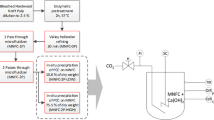Conclusions
The effect of textile auxiliaries on the bulk density and water vapor sorption of cellulose powder prepared from fibre waste from viscose manufacturing has been studied.
It has been shown that treatment of the cellulose powder with textile auxiliaries leads to an increase in its free-flowing properties and to a considerable improvement in the quality of the product obtained.
A composition based on S-9 mineral oil and an added emulsifier, which reduces the bulk density of the cellulose powder by 46–57%, is the most effective agent.
Similar content being viewed by others
Literature cited
M. I. Yurkina, V. V. Pavlova, et al., Khim. Prom-st', No. 6, 32 (1984).
I. M. Kuvshinnikov, Z. A. Tikhonovich, et al., Khim. Prom-st', No. 1, 25 (1984).
I. M. Kuvshinnikov, Khim. Prom-st', No. 3, 25 (1985).
Handbook on Analytical Control in the Manufacture of Artificial and Synthetic Fibres [in Russian], Khimiya, Moscow (1986).
Additional information
Translated from Khimicheskie Volokna, No. 2, pp. 27–28, March–April, 1987.
Rights and permissions
About this article
Cite this article
Agafonova, L.L., Glavochevskaya, R.A., Panova, L.N. et al. Effect of textile auxiliaries on the free-flowing cellulose power. Fibre Chem 19, 111–113 (1987). https://doi.org/10.1007/BF00552606
Received:
Issue Date:
DOI: https://doi.org/10.1007/BF00552606




